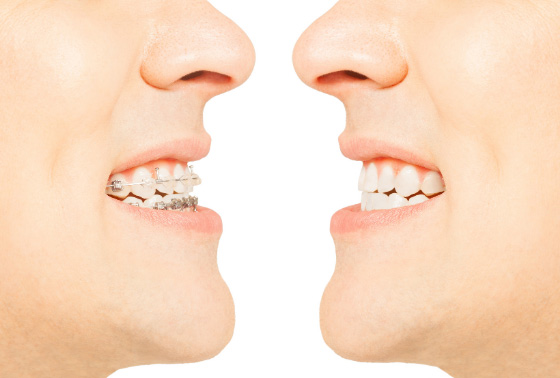8 Signs You Should See an Orthodontist
In some cases, orthodontic care is cosmetic, but the majority that seek orthodontic care will benefit from improved dental health that may prevent issues in the future. While some symptoms are more obvious than others, here’s a list of the most common reasons you should seek orthodontic care from a certified orthodontist in your area.
Before Treatment
Here’s a list of common reasons people make their first appointment at the orthodontist.
1. Overbite/Underbite/Crossbite/Openbite
There are a variety of misalignment types that can impact your teeth. The most common types are overbites, underbites, crossbites and openbites. Here is more information on each.
Overbite: Overbite is defined as the vertical overlapping of the upper teeth over the lower teeth. A deep overbite (or deep bite) occurs when the upper front teeth completely (or mostly) cover the lower front teeth. Often, this causes the lower front teeth to bite on the gums behind the upper front teeth, causing damage to the gum tissue and underlying bone.
Underbite: An underbite occurs when the lower front teeth protrude in front of the upper front teeth. It is often seen with a Class III malocclusion, where there is a large lower jaw, a small upper jaw, or a combination of the two.
Crossbite: A crossbite occurs when the top teeth fit inside of the bottom teeth. In a normal jaw relationship, the top teeth should be located outside of the bottom teeth. A crossbite can occur with the front teeth or with the back teeth. Crossbites can cause problems with biting and chewing.
Openbite: An openbite is defined as a lack of vertical overlap of the incisor (front) teeth. It results when the upper and lower front teeth do not touch when biting down. An openbite can be caused by abnormal growth of one of both jaws or it can be caused by a thumb or finger sucking habit. In some instances, a tongue thrust (which occurs when the tongue moves between the front teeth during swallowing) may also be a contributing factor to an openbite.
2. Mouth Pain
If you have any mouth or jaw pain, it’s a good idea to go see an orthodontist. Some issues are felt before they’re seen, and your orthodontist can help provide insight and possibly a solution.
3. Crowded Teeth
Crowding of the teeth is the most common problem associated with the need for orthodontic treatment. Many factors contribute to dental crowding. The most common reason for crowding is a discrepancy between the space available in each jaw and the size of the teeth. Crowding can lead to impacted teeth, a “bad bite”, and an unaesthetic appearance.
4. Speech Issues
If you or your child is struggling to say certain words, it may be time for a trip to the orthodontist. Though there are a lot of reasons speech issues arise, it could be a mouth issue.
During Treatment
Here’s a list of reasons people seek orthodontic care when they already have their braces on.
1. A Poking Wire
A sharp, poking wire can be caused from your teeth moving and adjusting. To help fix it, apply orthodontic wax to the end of the wire to put a barrier between the wire and your gums and/or check. Then, schedule an appointment with your orthodontist to help resolve the issue.
2. Damaged Bracket
Eating hard or sticky foods, or playing with your braces can cause your brackets to become loose and fall off. If something breaks, contact your orthodontist to schedule an appointment. In the meantime, apply orthodontic wax to the area if it’s uncomfortable and/or to avoid messing with it further.
3. Mouth Irritation
Your cheeks are used to rubbing against smooth teeth, not your appliances. Because of this, it will take some time for your mouth to become less sensitive. Place orthodontic wax over the areas causing the irritation until your cheeks and gums adjust. If you get sores or ulcers that seem to get larger over time, instead of smaller, contact your orthodontist for further instruction.
4. Broken Elastic Ligatures
Elastic ligatures, or those small, colorful rubber bands you choose at your routine appointment, connect your archwires to your brackets and hold them in place. If one breaks and you notice it missing, contact your orthodontist to schedule an appointment. Your braces are far less sturdy without them.
While this list isn’t exhaustive, it’s helpful to see the reasons why people first go to the orthodontist and why they might make an appointment during their treatment. If you have any questions or would like to schedule an appointment, contact us today!






